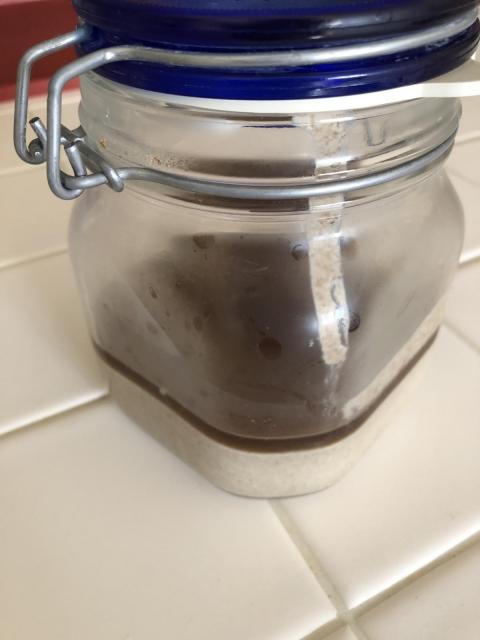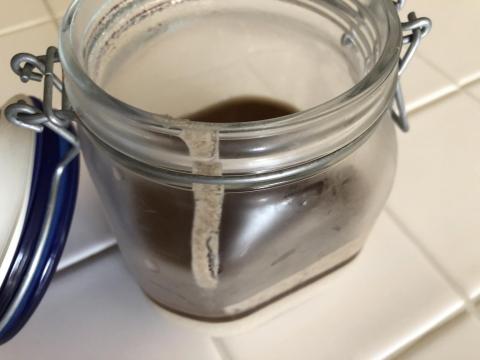February 11, 2021 - 9:28am

Is this normal (separation into layers, one of them brown)
Several years ago posters here were kind enough to help me get two sourdough starters up and running.
One Rye sourdough; the other KAF AP flour
For some time, though, after a few days (both when I stir and when I feed - which is usually weekly) the liquid in each container separates into two layers.
The top in each case is a watery brown. The thicker layers below (in both sourdough and All Purpose) are what looks like regular starter.
The two layers in each jar always easily combine again when I do stir them together.
But it somehow looks wrong. Photos of the sourdough
attached.Grateful for any guidance about what I may be doing wrong, please :-)
TIA!




Top liquidy layer is called hooch - basically, alcohol. It forms when the starter is not fed for a while. Either stir it in, or discard - but it's completely normal. Just feed it and it'll be back to normal soon enough, no problems.
Ilya! Thanks. I knew I'd get a friendly reception and help here. Thanks so much :-)
Yes, stirring always makes it disappear. Maybe I'm not feeding often enough?
Once a week at the moment.
Should I maybe discard (half?) and replenish with the same amount of water and flour?
I don't want to lose the essence of this starter.
Do what Abe tells you and you'll be golden! He's one of the starter gurus around here. I maintain my starter same as he does.
I didn't notice your unusual maintenance routine, that sure would cause the starter to starve.
Ilya - thanks. You bet!
I shall do just what Abe has kindly suggested.
For my money, you'r all golden gurus here., Very much appreciated :-)
Are you refrigerating? What ratio feed and at what stage is it refrigerated? I can feed every few weeks and there is never that much hooch. Something else seems to be going on.
Thanks, Abe!
Yes, always kept in the fridge.
I put in no more than a tablespoon to probably well more than a cup of starter. Once a week.
It's been like this for several years! Always topped up. Always kept in the fridge.
Maybe my ratio of new flour to old mixture is wrong.
I don't usually discard. Try to keep the viscosity like that of pancake batter.
Your help much appreciated.
No more than 1 tablespoon fresh flour to a cup of starter? My biggest question is how it's master this long?
Here's my maintenance schedule.
Feed scraps of starter with around about 50g water + 50g flour. Allow it to double then refrigerate. It'll stay in the fridge till it runs low and needs feeding again. When it comes to baking I'll keep dipping into it to build a levain.
When it's back down to scraps I'll take it out and re-feed. This way both my starter and levain builds always have a healthy feed.
Abe,
I used to bake (and so reduce the quantity of (sourdough) starter very regularly.
Now I'm just maintaining. (Or trying to!)
Thanks for your 'recipe'… half and half water + flour, I see. But that's at the start.
And, I think I see, you don't feed at all once in the fridge?
I'm beginning to think I should in fact, by now, restart everything from scratch? Which I don't mind :-)
Yes?
Maintain your starter with wholegrain rye flour. It's very hardy and so good for your starter. When it comes to ease rye is the way to go.
Trick is to build just enough that it allows for a few bakes without having to keep topping it up, by using it as a seed for a levain, but not too much where it goes too long between feeds.
While it's in the fridge there's no need to keep feeding. It can stay there for a week or two, or even three, before it begins to build up hooch and by then it's run low anyway and needs a feed.
Try giving your starter some TLC and see how it reacts. No need to throw the towel in and start again. Take 10g starter and feed it 50g water + 50g wholegrain rye and see how it reacts. You might have to feed it a few times to get it back to full health but once it's strong feed it one last time and refrigerate when doubled. This way it's built up a good population of yeasts and bacteria but it hasn't peaked so it's got reserves and can last a while in the fridge.
Fantastic! Thanks, Abe…
I'll do just as you say.
The only rye at KAF seems to be this one; any good? Or is there another online source (for wholegrain rye) that you'd recommend, please?
Could I also use this from KAF? Or, again, do you know of something better, please?
Do the instructions/suggestions in your last paragraph refer to a revitalization/TLC process outside of the fridge? Or am I rebuilding it always cold?
Mich appreciated :-)
It's not 100% wholegrain rye but a mix and will do just fine. The second one is a starter. If this one fails then you can either make another one from scratch or buy a starter but I favour making your own.
The TLC for bringing it back to health is all done at room temperature. Give your starter a feed and see how it reacts. When it has bubbled up and peaked feed it again and so on. Once you see it's strong and steady then give it another feed but refrigerate when doubled.
If you don't have any rye flour now then you can begin with using some other flour till the rye arrives. Any flour will do but if you have any wholegrain that will be better.
That's very helpful, Abe. Thanks so much!
I think I've really let my old starter disintegrate. You've put me back on the right path. Very grateful. Take care!
With some coaxing and tlc starters can be brought back to health. Just takes a little patience and carefully timed feeds. Once you've done the first feed just keep it warm and stir it twice a day until it wakes up. Once it does come back to life then strengthen with further feeds.
Let us know how it goes.
P.s. while I'm in favour of stirring a little hooch back in for flavour I'm thinking this amount of hooch after neglect should be carefully poured off before feeding the healthier starter beneath.
Will do. Thanks!
Oh it's not gone for good. Standard procedure for reviving/repairing a funky starter is, a little starter,a lot of food, warmth and a little time, don't forget to stir a couple times a day. By the time you get another going and mature this one will be back in action.
The interesting thing in all this is what happened. Here ya go;
With fridge storage you only really need a little food to keep things alive. But that doesn't mean a healthy strong starter. Your feed amounts believe it or not, aren't too far off for a starter that lives in the fridge. The problem is it's a little shy of what's really needed, and this is a perfect example of what happens over time when a feed schedule is off, even by just a little. Everything hums along just fine, and then it doesn't, and usually quickly.
So, bring this one back using the above, get another going if ya like (why not, it's fun!), And bump the food up to 3 teaspoons when ya get going again. Make it a race, see which comes to life first, the old or the new! Enjoy!
Thanks, phaz!
Makes perfect sense. I believe you've described just what happened, what I did :-(
But I've learnt my lesson.
What a friendly and helpful forum. Best to you all :-)
Thanking Abe, Ilya and Phaz again, just wanted to say that - following your instructions - I already (third day) have what to me look like spectacularly healthy starters.
Credit too to KAF, Bob's Red Mill and Californian desert yeasts :-)
Probably ready to try my first loaf at the weekend.
Take care!
I'm looking forward to your first bake with your newly revived starters.
Thanks, Abe. Yes :-)
I've noticed though (while I'm still feeding in preparation for a first bake) that when I feed the starter, it is rising dramatically (doubling in size up my crock).
If I leave it, it stays that way. Very light and fluffy - full of air, presumably?
But if I stir it again at night after - say - eight hours, I lose all of that day's rise.
Is it actually better not to stir a second time, after each day's feeding, please?
Could I be 'damaging' the starter; or 'impairing it' in some way?
Thoroughly enjoying this; your help very much appreciated… is there perhaps some way that I could contribute (via PayPal etc) to the costs of this site?
A starter is strongest when it doesn't rise anymore, so stir till there's no rise then feed. Enjoy!
Thanks, phaz - so a second stir in the day is doing no harm?
I usually have my starter on my kitchen counter and whenever I feel like I'll stir it up, at least 2x a day, usually morning and night. But for a reason, I keep about 1/3 of my jar full of starter, use it all for a bread, dump in a bunch of food, then just stir till I need it again. If I don't mix it a few times the rise will overflow pretty quick. No matter, mixing is a good thing for a starter, basically you can't over mix a starter. Enjoy!
As always, phaz, you've been extremely helpful. All very clear. Will do. Thanks again :-)
Abe wrote:
Well, here it is. And thanks to everyone who's so kindly helped me!
I haven't tasted it yet - but I really couldn't ask for much more in terms of rise, colour and shape, could I?!
First sourdough loaf.jpg
Thanks so much to Ilya, Abe, phaz for all your encouragement, suggestions and support!
I decided to ‘move up’ to what is surely a more ‘artisanal’ method with fewer compromises. I used longer bulk fermentation, proofing and a Dutch Oven.
I still have lots to learn - but here’s my first effort, fresh out of the oven.
If it tastes as good as it looks, I shall be pleased.
Thanks again!
First Dutch Oven Sourdough.jpg